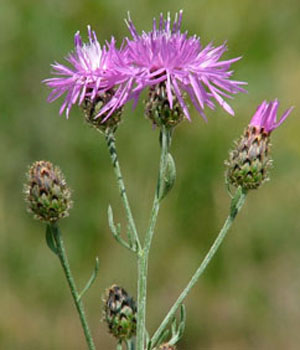Invasive Plants and Agricultural Pest Management
Welcome to Alaska's Invasive Plant Program. Our program coordinates prevention, outreach and management strategies for invasive plant issues through collaboration with land managers, agencies, organizations and policy makers across Alaska. These efforts are guided by the implementation of our Strategic Plan and relevant noxious weed regulations and policies. Our goal is to help keep Alaska's pristine landscapes and natural resources free from impacts of noxious and invasive plants.
PMC Programs
- PMC Home Page
- Horticulture
- Industrial Hemp
- Invasive Plants
- Plant Pathology

5310 S Bodenburg Spur
Palmer, AK 99645
Phone: 907-745-4469
Fax: 907-746-1568
Mon. - Fri.
8 a.m. - 4 p.m.
Click Map For Directions
View Larger Map
Spotted Knapweed (Centaurea stoebe)
AK Natural Heritage Program Invasiveness Ranking: 86
A native to Europe and Asia, the spotted knapweed has become a serious problem in pastures and rangelands of the western lower 48.
- Biology
- Impact
- Distribution
- Taking Action
- Resources
- • Biennial to short-lived perennial
- • Rosette leaves are deeply divided while stem leaves are alternate and are increasingly smaller toward the top
- • Stems are extensively branched
- • Flowers are urn-shaped, solitary at the end of each branch and purplish-pink
- • Flowers grow up to 1 inch wide and are composed of purple, disc-like florets
- • The dark comb-like fringe on the tip of the bracts, just below the flower petals, give the flower a &quo;spotted&quo; appearance
- **Spotted knapweed can be confused with Alaska's native diffuse knapweed (C. diffusa). The native diffuse knapweed has spine-tipped bracts, not comb-like tips on its bracts.

Spotted knapweed often forms dense stands in natural communities decreasing diversity of native vegetation, and degrading the forage quality for wildlife habitats. Spotted knapweed has allelopathic (toxic) properties, also reducing the native plant communities. Infestations have also been shown to increase the erosion of topsoil, further altering the surrounding habitat and natural system. Due to its growth habits and environmental habitat, Alaska's agricultural areas could be greatly impacted by spotted knapweed if not managed both with inventory and eradication.
The effectiveness of Early Detection and Rapid Response (EDRR) for known spotted knapweed infestations in Alaska has reduced the number of sites to less than 10 from the previous 23 sites. In 2013, only a single plant was found at a managed site near Sutton, which had over 500 plants in 2012. In Fairbanks, only one plant has been found and managed, growing along a rock filled ditch. With continual surveying, monitoring and response to spotted knapweed, it may someday be completely eradicated from the state.
Habitat: cultivated fields and pastures, roadsides and railways and pipelines
Early Detection and Rapid Response (EDRR) works! Controlling the spread of spotted knapweed is crucial to protecting Alaska's native plants. If found, call 1-877-INVASIV.
Presently, infestations of spotted knapweed in Alaska are mostly managed manually by digging or pulling individual plants. This has proven effective in Alaska because infestations are small (< 0.5 acre). Spotted knapweed also does not have creeping roots, allowing manual management to be effective. If larger infestations are discovered, long-term control requires a combination of grazing management (to prevent the plants from going to seed), herbicide use, and possibly biological control. Areas should also be monitored for several years because seeds of spotted knapweed can remain viable in the soil for up to five years.
